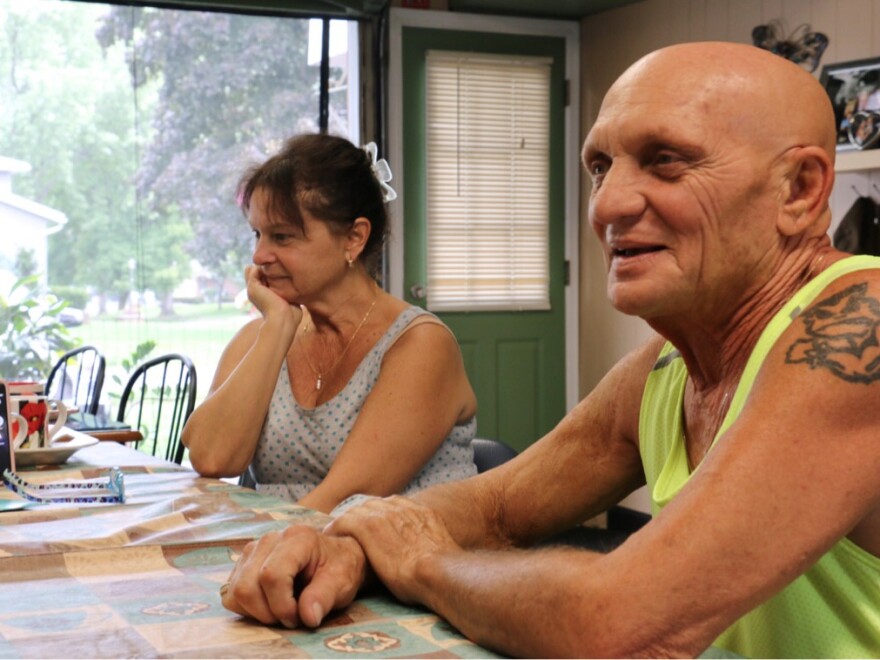Dave Lana was 61 when he died of an opioid overdose in January.
It was fentanyl, his wife, Angela, said. He got the drugs in Monroe County and overdosed a few miles away at his father’s house in Ontario County.
Dave had struggled with drug addiction since he was a young teenager, said Angela and his older brother John. John, now 64, said he’s in long-term recovery from his own addiction, and he’s been drug-free for almost 20 years. Still, he’s had his own close brushes with death.
“I’ve had to be brought back a couple of times from overdoses,” John said. “The paramedics had to bring me back. I was gone. They said I was gray, I wasn’t breathing.”
Both brothers have had successful careers. Dave was a union carpenter – he was doing some repair work at his father’s house the day he died, Angela said – and John was a jockey and horse trainer.
Neither fits the most common profile of a person addicted to opioids. But both are reminders of addiction’s ability to target anyone, say mental health experts, including – and especially – people over 50.
That group is the fastest-growing age group for opioid fatalities in Monroe County, up almost 400 percent between 2014 and 2017, according to data from the medical examiner’s office. Last year, the oldest person to die from an opioid overdose was 82, the sheriff’s heroin task force said in a July press release.
“We need to think about the older population and their susceptibility to opioid addiction,” said Cathy Saresky, who directs clinical innovations for Rochester’s Catholic Family Center. The organization provides services for people with drug addictions.
“We have to pay attention. Our population is shifting and getting older,” Saresky said.
At Lifespan, which provides resources and support to seniors in the Rochester area, the brochures that describe the geriatric addiction program had to be revised recently to emphasize information about opioids, said Paul Caccamise, the organization’s vice president for programs.
Caccamise said Lifespan’s leadership realized they needed to address the emergence of opioids as a primary contributor to addiction in older populations.
It starts often with prescription painkillers. The elderly population has a higher-than-average rate of major medical operations, and people are often prescribed strong painkillers, like oxycontin, codeine and Vicodin, to dull the discomfort, said Caccamise. But those prescriptions are expensive, and they eventually run out.

“When the doctor no longer prescribes it, then they’re getting it on the street,” said Ann Olin, who directs the geriatric addiction program at Lifespan. “And the pills are very expensive, and so when they run out of money, they’re turning to using heroin, which is much cheaper.”
John Lana had a close call, even after he had committed to sobriety. “I had open heart surgery. Of course, the first couple days – they break your chest right open – I had morphine before I even knew it,” he said. “I told them I can’t be taking any more.”
John said his doctors never asked him if he was OK with opioids. Olin said that’s a story that’s all too common: older adults developing a dependence on legal pills, and health care workers who don’t realize that the elderly can get addicted, too.
Olin is both the administrator of Lifespan’s geriatric addiction program and one of its two geriatric addiction counselors, and she said her caseload is growing. Demand outpaces Lifespan’s ability to supply support and counseling. “There’s definitely a need,” she said. “We would grow this program if we had the resources.”
When WXXI News visited her office in Brighton on a Friday morning, Olin had already returned from visiting a client at his home. “Often I come in very early,” she said. “Yesterday I had three clients in the morning and then I came back for lunch.” Olin said it’s not uncommon for her to see five or six clients in one day.
In her office at the Catholic Family Center headquarters in downtown Rochester, Sabrina Sharpe, a clinician there, described a similarly heavy caseload, with 34 current clients. “I have all different walks of life: all ages, all backgrounds, all different stages of recovery.” Clients over 50 make up a sizeable, and growing, portion of that total, she said.

Even with her rising total of older clients, Sharpe said, there are likely some who aren’t getting the help they need. “There’s a stigma,” she said, “and they might not be mobile enough to leave their homes.”
Olin and Caccamise at Lifespan echoed those concerns. “That’s why we do home visits,” Olin said. “We take in a mindset that this is a difficult topic. We do our best to make it non-threatening.”
But even with the best support, Olin said, there are barriers to getting addiction treatment to the older generation that don’t exist with younger clients. “The older adult population is thinking, you know, we don’t air our dirty laundry; we don’t talk about our problems,” she said.
And, experts say, the symptoms of opioid dependence are similar to aging. For that reason, they can be difficult to detect.
Leaders at Lifespan and Catholic Family Center both said one of the most important things anyone can do is check in with their older family members. The better people know their families, they said, the more likely it is they’ll catch a problem early.
This story is part of “New York’s Opioid Crisis,” a partnership of public broadcasting stations across the state working to draw attention to this public health crisis.




